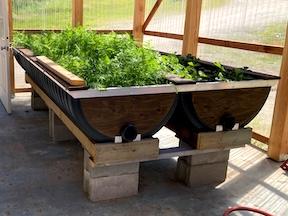
When Rick Ratcliff heard about some highly discounted corrugated HPDE culverts, he knew he would find a use for them. It took a few years, but today, the 30-in. dia. pipes are used as raised garden beds.
“I have three that are just under 10 ft. in length in my greenhouse and plan to add more outside,” says Ratcliff.
Using the culverts has been easier than getting them in the first place. While discounted by about 60 percent from their full price, the 20-ft. long culverts were more than 400 miles away. With the help of a mobile generator and an 8 1/4-in. Skil saw, Ratcliff was able to haul them home.
“The saw had enough blade to cut through the culvert wall,” recalls Ratcliff. “I was able to rip them down the seam line on each side and stack them for the trip.”
Ratcliff cut the 20-ft. lengths in half for the greenhouse raised beds and rested them on treated plywood, cradled by 4 by 4s. The plywood base sits on two layers of concrete block for height. Where they bump up to each other, he slipped 1 by 5-in. aluminum C-channel over the neighboring edges.
“I screwed aluminum angle irons to the outside edges of the beds and the ends and used 5/4 decking for the top edges,” says Ratcliff. “I used a cardboard template to cut half circles of plywood for the ends of the culverts and ran 4-in. drain tile along the bottom to ventilate the soil. I also drilled holes in the bottom of each ridge to drain excess water.”
Ratcliff covered the drain tile in wood chips and then filled the beds with a soil mix that included compost made from food waste and litter from a chicken farm. In retrospect, he suspects the soil mix was too rich. The first year’s crop was not what he hoped for.
“I planted tomatoes in it this spring,” says Ratcliff. “I got lots of vegetation but not a lot of fruit.”
He plans to add grass clippings and peat moss to leaven the mixture. He also notes that the carrot variety that grew 8 to 10 in. long in his outdoor garden beds was short and chubby in the indoor bed.
“I think the soil in the greenhouse beds may have been too warm for the carrots,” says Ratcliff. “The air moves through the greenhouse but can get a bit warm.”
While the first harvest might not have been up to par, Ratcliff is looking forward to developing outside raised beds with the remaining culverts. “I hope they’ll avoid problems I have with perennial weeds with rhizomes like quackgrass and marestail,” he says. “However, for use outside, I likely won’t go to the expense of capping the sides.”
Contact: FARM SHOW Followup, Rick Ratcliff, Box 10, Bella Coola, B.C., Canada V0T 1C0 (ph 250-982-2597; mrbikebc@hotmail.com).
